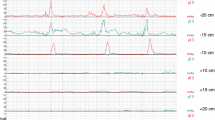Summary
The incomplete information in the literature on the mechanism of sigmoid storage and evacuation and its relation to the rectum has prompted our study in 18 mongrel dogs. A condom-ended catheter was introduced into the sigmoid and infused with carbon dioxide (CO2) at 2 rates: slow and rapid. The pressure responses of sigmoid colon, rectosigmoid junction (RSJ), rectum and rectal neck to sigmoid distension were determined; the EMG activity of the external anal sphincter and levator ani was also evaluated. Upon slow sigmoid distension up to a mean of 93.6±3.2 ml, no pressure response occurred in the sigmoid, RSJ, rectum or rectal neck. Distension above this level induced an increase of sigmoid pressure (p<0.001), a decrease of RSJ pressure (p<0.05), but no change in rectal or rectal neck pressure (p>0.05); the balloon was dispelled to the rectum. EMG of external anal sphincter and levator showed no activity. Balloon expulsion to the rectum effected a pressure increase in the rectum (p<0.001), a decrease in the rectal neck (p<0.01), and an increase in the RSJ (p<0.01), while the sigmoid showed no response (p>0.05), and the balloon was dispelled to the exterior. Rapid sigmoid distension induced an increase of sigmoid pressure (p<0.001) and a decrease of RSJ pressure (p<0.05) at approximately half the volume needed with slow distension. The sigmoid colon adapts the new contents until a certain volume is attained, when it contracts dispelling its contents to rectum. Rapid distension induces sigmoid contraction at a smaller volume than slow distension. Rectum and rectal neck did not respond to sigmoid distension or contraction, and vice versa. Sigmoid contraction initiates RSJ relaxation, while rectal contraction evokes RSJ contraction.
Zusammenfassung
Die unvollständige Information in der Literatur über den Mechanismus der sigmoidalen Speicherung und Entleerung sowie ihre Beziehung zum Rektum führte zu unserer Untersuchung an 18 Mischlingshunden. Ein mit einem Kondom überzogener Katheter wurde in das Sigmoid eingeführt und über ihn Kohlendioxid (CO2) einmal schnell und einmal langsam infundiert. Die Druckreaktionen von Sigmoid, rektosigmoidalem Übergang, Rektum und Rektumhals auf die Dehnung des Sigmoids wurden bestimmt. Außerdem wurde die EMG-Aktivität des äußeren Analsphinkters und des Levator ani gemessen. Bei langsamer sigmoidaler Distension bis zu einem Mittelwert von 93,6±3,2 ml konnte keine Druckreaktion im Sigmoid, rektosigmoidalen Übergang, Rektum und Rektumhals verzeichnet werden. Eine Dehnung über den genannten Wert hinaus führte zu einer Erhöhung des sigmoidalen Druckwertes (p<0,001), einer Reduzierung des Druckes im rektosigmoidalen Übergang (p<0,05), aber zu keiner Änderung der Druckwerte im Rektum oder Rektumhals (p>0,05). Der Ballon wurde zum Rektum gezogen. Das EMG des äußeren Analsphinkters und des Levators zeigte keine Aktivität. Die ballonverlagerung zum Rektum führtezu einer Druckerhöhung im Rektum (p<0,001), einer Reduzierung im Rektumhals (p<0,01) und zu einer Erhöhung im rektosigmoidalen Übergang (p<0,01), während im Sigmoid keine Veränderung zu sehen war (p>0,05) und der Ballon ausgeschieden wurde. Eine schnelle sigmoidale Distension führte zur Druckerhöhung im Sigmoid (p<0,001) und einer Abnahme des Druckes am rektosigmoidalen Übergang (p<0,05) bei ungefähr der Hälfte des Volumens, das bei einer langsamen Distension benötigt wurde. Das Sigmoid paßt sich dem neuen Inhalt an, bis ein bestimmtes Volumen erreicht ist, dann kontrahiert es und verlagert den Inhalt in das Rektum. Die schnelle Dehnung führt zur sigmoidalen Kontraktion bei kleineren Volumina als bei langsamer Dehnung. Rektum und Rektumhals reagieren nicht auf die sigmoidale Distension oder Kontraktion und umgekehrt. Die Kontraktion des Sigmoids initiiert die Relaxation des rektosigmoidalen Übergangs, während die rektale Kontraktion die Kontraktion des rektosigmoidalen Übergangs herbeiführt.
Similar content being viewed by others
References
Denny-Brown D, Robertson EG. An investigation of the nervous control of defecation. Brain 1935;58:256–310.
Goligher J, Duthie H. Surgical anatomy and physiology of the anus, rectum and colon. In: Goligher J, ed. Surgery of the anus, rectum and colon. 5th, edn. London: Bailliere Tindall 1984;29–43.
Gowers WR. The automatic action of the sphincter ani. Proc R Soc Lond [Med] 1877;26:77.
Guyton AC. Movement of food through the alimentary tract. In: Guyton AC, ed. Human physiology and mechanisms of disease, 4th edn. Philadelphia: Saunders, 1987:495.
Martin, E, Burden VG. The surgical significance of the rectosigmoid sphincter. Ann Surg 1927;86:86–9.
Mayo WJ. Surgery of the rectosigmoid. Surg Gynecol Obstet 1917;25:616–21.
McMinn RMH. Abdomen. In: Minn RMH, ed. Last's anatomy: regional and applied, 8th edn. Edinburgh: Churchill Livingstone, 1990:319–32.
O'Beirne J. New views of the process of defecation and their application to the pathology and treatment of diseases of the stomach, bowels and other organs. Dublin: Hodges and Smith, 1833.
Shafik A., Mahfouz SM. Histologic study of the rectosigmoid junction with special reference to the presence or not of an anatomical sphincter (submitted).
Shafik A. Detrusor-sphincter dyssynergia syndrome. A new syndrome and its treatment by external sphincter myotomy. Eur Surg Res 1990;22:243–8.
US Public Health Services. The guide for care and use of laboratory animals. NIH Pub 1:1989:5.
Author information
Authors and Affiliations
Rights and permissions
About this article
Cite this article
Shafik, A. Functional activity of the sigmoid colon and rectum. Coloproctology 19, 236–241 (1997). https://doi.org/10.1007/BF03043456
Received:
Issue Date:
DOI: https://doi.org/10.1007/BF03043456




